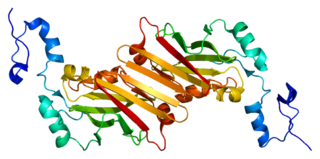Related Research Articles
The Protein Data Bank (PDB) is a database for the three-dimensional structural data of large biological molecules such as proteins and nucleic acids, which is overseen by the Worldwide Protein Data Bank (wwPDB). These structural data are obtained and deposited by biologists and biochemists worldwide through the use of experimental methodologies such as X-ray crystallography, NMR spectroscopy, and, increasingly, cryo-electron microscopy. All submitted data are reviewed by expert biocurators and, once approved, are made freely available on the Internet under the CC0 Public Domain Dedication. Global access to the data is provided by the websites of the wwPDB member organisations.

The Structural Classification of Proteins (SCOP) database is a largely manual classification of protein structural domains based on similarities of their structures and amino acid sequences. A motivation for this classification is to determine the evolutionary relationship between proteins. Proteins with the same shapes but having little sequence or functional similarity are placed in different superfamilies, and are assumed to have only a very distant common ancestor. Proteins having the same shape and some similarity of sequence and/or function are placed in "families", and are assumed to have a closer common ancestor.

Thioredoxin is a class of small redox proteins known to be present in all organisms. It plays a role in many important biological processes, including redox signaling. In humans, thioredoxins are encoded by TXN and TXN2 genes. Loss-of-function mutation of either of the two human thioredoxin genes is lethal at the four-cell stage of the developing embryo. Although not entirely understood, thioredoxin is linked to medicine through their response to reactive oxygen species (ROS). In plants, thioredoxins regulate a spectrum of critical functions, ranging from photosynthesis to growth, flowering and the development and germination of seeds. Thioredoxins play a role in cell-to-cell communication.
The European Bioinformatics Institute (EMBL-EBI) is an intergovernmental organization (IGO) which, as part of the European Molecular Biology Laboratory (EMBL) family, focuses on research and services in bioinformatics. It is located on the Wellcome Genome Campus in Hinxton near Cambridge, and employs over 600 full-time equivalent (FTE) staff.
The Protein Data Bank (PDB) file format is a textual file format describing the three-dimensional structures of molecules held in the Protein Data Bank, now succeeded by the mmCIF format. The PDB format accordingly provides for description and annotation of protein and nucleic acid structures including atomic coordinates, secondary structure assignments, as well as atomic connectivity. In addition experimental metadata are stored. The PDB format is the legacy file format for the Protein Data Bank which has kept data on biological macromolecules in the newer PDBx/mmCIF file format since 2014.

Sir Thomas Leon Blundell, is a British biochemist, structural biologist, and science administrator. He was a member of the team of Dorothy Hodgkin that solved in 1969 the first structure of a protein hormone, insulin. Blundell has made contributions to the structural biology of polypeptide hormones, growth factors, receptor activation, signal transduction, and DNA double-strand break repair, subjects important in cancer, tuberculosis, and familial diseases. He has developed software for protein modelling and understanding the effects of mutations on protein function, leading to new approaches to structure-guided and Fragment-based lead discovery. In 1999 he co-founded the oncology company Astex Therapeutics, which has moved ten drugs into clinical trials. Blundell has played central roles in restructuring British research councils and, as President of the UK Science Council, in developing professionalism in the practice of science.

Crystallographic Information File (CIF) is a standard text file format for representing crystallographic information, promulgated by the International Union of Crystallography (IUCr). CIF was developed by the IUCr Working Party on Crystallographic Information in an effort sponsored by the IUCr Commission on Crystallographic Data and the IUCr Commission on Journals. The file format was initially published by Hall, Allen, and Brown and has since been revised, most recently versions 1.1 and 2.0. Full specifications for the format are available at the IUCr website. Many computer programs for molecular viewing are compatible with this format, including Jmol.
The EM Data Bank or Electron Microscopy Data Bank (EMDB) collects 3D EM maps and associated experimental data determined using electron microscopy of biological specimens. It was established in 2002 at the MSD/PDBe group of the European Bioinformatics Institute (EBI), where the European site of the EMDataBank.org consortium is located. As of 2015, the resource contained over 2,600 entries with a mean resolution of 15Å.

Dame Janet Maureen Thornton, is a senior scientist and director emeritus at the European Bioinformatics Institute (EBI), part of the European Molecular Biology Laboratory (EMBL). She is one of the world's leading researchers in structural bioinformatics, using computational methods to understand protein structure and function. She served as director of the EBI from October 2001 to June 2015, and played a key role in ELIXIR.

E3 ubiquitin-protein ligase SIAH1 is an enzyme that in humans is encoded by the SIAH1 gene.

Helen Miriam Berman is a Board of Governors Professor of Chemistry and Chemical Biology at Rutgers University and a former director of the RCSB Protein Data Bank. A structural biologist, her work includes structural analysis of protein-nucleic acid complexes, and the role of water in molecular interactions. She is also the founder and director of the Nucleic Acid Database, and led the Protein Structure Initiative Structural Genomics Knowledgebase.

The Protein Common Interface Database (ProtCID) is a database of similar protein-protein interfaces in crystal structures of homologous proteins.

Steven Elliot Brenner is a professor at the Department of Plant and Microbial Biology at the University of California Berkeley, adjunct professor at the Department of Bioengineering and Therapeutic Sciences at the University of California, and San Francisco Faculty scientist, Physical Biosciences at the Lawrence Berkeley National Laboratory.

WeNMR is a worldwide e-Infrastructure for NMR spectroscopy and structural biology. It is the largest virtual Organization in the life sciences and is supported by EGI.

Macromolecular structure validation is the process of evaluating reliability for 3-dimensional atomic models of large biological molecules such as proteins and nucleic acids. These models, which provide 3D coordinates for each atom in the molecule, come from structural biology experiments such as x-ray crystallography or nuclear magnetic resonance (NMR). The validation has three aspects: 1) checking on the validity of the thousands to millions of measurements in the experiment; 2) checking how consistent the atomic model is with those experimental data; and 3) checking consistency of the model with known physical and chemical properties.
Michael Joseph Ezra Sternberg is a professor at Imperial College London, where he is director of the Centre for Integrative Systems Biology and Bioinformatics and Head of the Structural bioinformatics Group.

Randy John Read is a Wellcome Trust Principal Research Fellow and professor of protein crystallography at the University of Cambridge.

Jill Trewhella FAAAS FLANL Dist FRSN is a biophysicist who has worked in both Australia and the United States.
Julian John Thurstan Gough was a Group Leader in the Laboratory of Molecular Biology (LMB) of the Medical Research Council (MRC). He was previously a professor of bioinformatics at the University of Bristol.

The Macromolecular Crystallographic Information File (mmCIF) also known as PDBx/mmCIF is a standard text file format for representing macromolecular structure data, developed by the International Union of Crystallography (IUCr) and the Protein Data Bank It is an extension of the Crystallographic Information File (CIF), specifically for macromolecular data, such as proteins and nucleic acids, incorporating elements from the PDB file format.
References
- ↑ "Looking back on 2016".
- ↑ "Gerard Kleywegt research group page at the EBI". Archived from the original on 2014-10-20.
- ↑ Garwoord, Jeremy (May 2009) "A Guardian of Structural Integrity". Lab Times. pp. 19-23
- ↑ Berman, H. M.; Kleywegt, G. J.; Nakamura, H.; Markley, J. L.; Burley, S. K. (2010). "Safeguarding the integrity of protein archive". Nature. 463 (7280): 425. doi:10.1038/463425c. PMC 4456675 . PMID 20110969.
- ↑ Lewis, T. E.; Sillitoe, I; Andreeva, A; Blundell, T. L.; Buchan, D. W.; Chothia, C; Cozzetto, D; Dana, J. M.; Filippis, I; Gough, J; Jones, D. T.; Kelley, L. A.; Kleywegt, G. J.; Minneci, F; Mistry, J; Murzin, A. G.; Ochoa-Montaño, B; Oates, M. E.; Punta, M; Rackham, O. J.; Stahlhacke, J; Sternberg, M. J.; Velankar, S; Orengo, C (2015). "Genome3D: Exploiting structure to help users understand their sequences". Nucleic Acids Research. 43 (Database issue): D382-6. doi:10.1093/nar/gku973. PMC 4384030 . PMID 25348407.
- ↑ Lewis, T. E.; Sillitoe, I; Andreeva, A; Blundell, T. L.; Buchan, D. W.; Chothia, C; Cuff, A; Dana, J. M.; Filippis, I; Gough, J; Hunter, S; Jones, D. T.; Kelley, L. A.; Kleywegt, G. J.; Minneci, F; Mitchell, A; Murzin, A. G.; Ochoa-Montaño, B; Rackham, O. J.; Smith, J; Sternberg, M. J.; Velankar, S; Yeats, C; Orengo, C (2013). "Genome3D: A UK collaborative project to annotate genomic sequences with predicted 3D structures based on SCOP and CATH domains". Nucleic Acids Research. 41 (Database issue): D499-507. doi:10.1093/nar/gks1266. PMC 3531217 . PMID 23203986.
- ↑ Jones, T. A.; Kleywegt, G. J. (2007). "Experimental Data for Structure Papers". Science. 317 (5835): 194–195. doi:10.1126/science.317.5835.194c. PMID 17626864.
- ↑ Kleywegt, G. J.; Jones, T. A. (1996). "Phi/psi-chology: Ramachandran revisited". Structure. 4 (12): 1395–400. doi: 10.1016/s0969-2126(96)00147-5 . PMID 8994966.
- ↑ Read, R. J.; Adams, P. D.; Arendall Wb, 3rd; Brunger, A. T.; Emsley, P; Joosten, R. P.; Kleywegt, G. J.; Krissinel, E. B.; Lütteke, T; Otwinowski, Z; Perrakis, A; Richardson, J. S.; Sheffler, W. H.; Smith, J. L.; Tickle, I. J.; Vriend, G; Zwart, P. H. (2011). "A new generation of crystallographic validation tools for the protein data bank". Structure. 19 (10): 1395–412. doi:10.1016/j.str.2011.08.006. PMC 3195755 . PMID 22000512.
{{cite journal}}: CS1 maint: numeric names: authors list (link) - ↑ Read, R. J.; Kleywegt, G. J. (2009). "Case-controlled structure validation". Acta Crystallographica Section D. 65 (Pt 2): 140–7. doi:10.1107/S0907444908041085. PMC 2631636 . PMID 19171969.
- ↑ Kleywegt, G. J.; Read, R. J. (1997). "Not your average density". Structure . 5 (12): 1557–69. doi: 10.1016/s0969-2126(97)00305-5 . PMID 9438862.
- ↑ Montelione, G. T.; Nilges, M; Bax, A; Güntert, P; Herrmann, T; Richardson, J. S.; Schwieters, C. D.; Vranken, W. F.; Vuister, G. W.; Wishart, D. S.; Berman, H. M.; Kleywegt, G. J.; Markley, J. L. (2013). "Recommendations of the wwPDB NMR Validation Task Force". Structure. 21 (9): 1563–70. doi:10.1016/j.str.2013.07.021. PMC 3884077 . PMID 24010715.
- ↑ Berman, H. M.; Kleywegt, G. J.; Nakamura, H; Markley, J. L. (2013). "How community has shaped the Protein Data Bank". Structure. 21 (9): 1485–91. doi:10.1016/j.str.2013.07.010. PMC 4435976 . PMID 24010707.
- ↑ Berman, H. M.; Kleywegt, G. J.; Nakamura, H; Markley, J. L. (2013). "The future of the protein data bank". Biopolymers. 99 (3): 218–22. doi:10.1002/bip.22132. PMC 3684242 . PMID 23023942.
- ↑ Berman, H. M.; Kleywegt, G. J.; Nakamura, H; Markley, J. L. (2012). "The Protein Data Bank at 40: Reflecting on the past to prepare for the future". Structure. 20 (3): 391–6. doi:10.1016/j.str.2012.01.010. PMC 3501388 . PMID 22404998.
- ↑ Berman, H. M.; Kleywegt, G. J.; Nakamura, H.; Markley, J. L.; Burley, S. K. (2010). "Safeguarding the integrity of protein archive". Nature. 463 (7280): 425. doi:10.1038/463425c. PMC 4456675 . PMID 20110969.
- ↑ Berman, H. M.; Kleywegt, G. J.; Nakamura, H; Markley, J. L. (2014). "The Protein Data Bank archive as an open data resource". Journal of Computer-Aided Molecular Design. 28 (10): 1009–14. doi:10.1007/s10822-014-9770-y. PMC 4196035 . PMID 25062767.
- ↑ Berman, H. M.; Burley, S. K.; Kleywegt, G. J.; Nakamura, H; Markley, J. L. (2014). "Response to on prompt update of literature references in the Protein Data Bank". Acta Crystallographica Section D. 70 (Pt 10): 2780. doi:10.1107/S1399004714020513. PMC 4984264 . PMID 25286863.